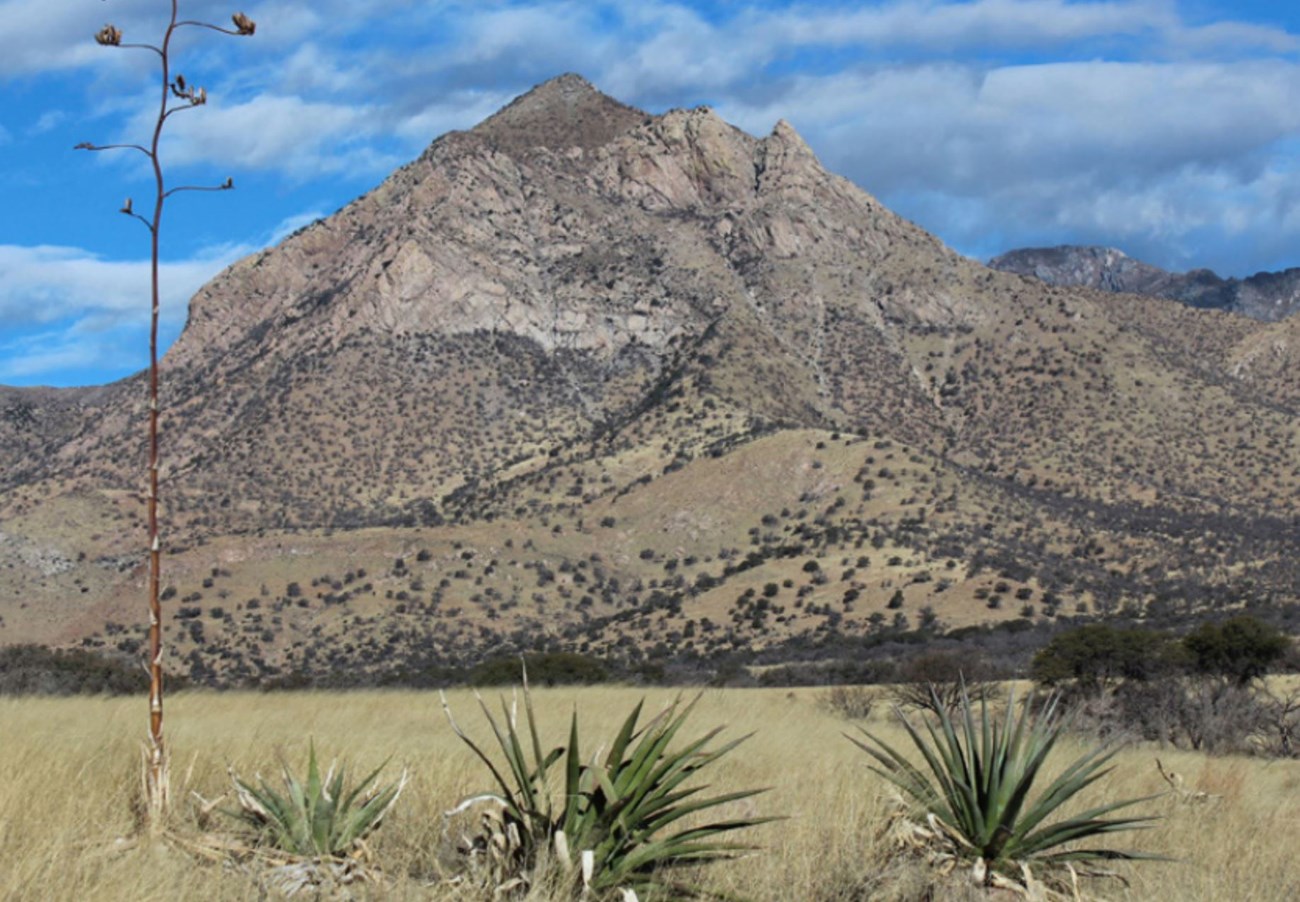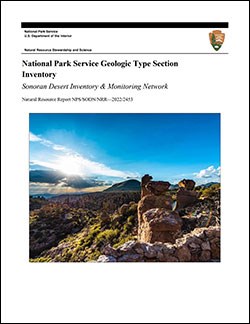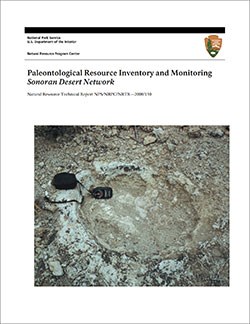
Geology and Stratigraphy of the Sonoran Desert I&M Network Parks
The Sonoran Desert Network Inventory & Monitoring Network (SODN) consists of 10 park units in central and southern Arizona and one park unit in southwestern New Mexico. These units are characteristic of the upper Sonoran subdivision of the Sonoran Desert Ecoregion and the Apache Highlands Ecoregion, and include Casa Grande Ruins National Monument, Chiricahua National Monument, Coronado National Memorial, Fort Bowie National Historic Site, Gila Cliff Dwellings National Monument, Montezuma Castle National Monument, Organ Pipe Cactus National Monument, Saguaro National Park, Tonto National Monument, Tumacácori National Monument, and Tuzigoot National Monument. The parks that comprise the Sonoran Desert Network protect a combined 179,801 hectares (444,299 acres) of wilderness and vary in size from 145 hectares (360 acres) in Tumacácori to 133,825 hectares (330,689 acres) in Organ Pipe Cactus.
The park units of the Sonoran Desert Network are composed of a complex assemblage of sedimentary, igneous, and metamorphic rocks with widely varying ages, from approximately 2-billion-year-old Precambrian surface exposures to relatively recent (ca. 700 CE) volcanic rocks in the Pinacate region near the international border. During the Cenozoic Era, significant changes in plate motion occurred from the Eocene through the Miocene ~35–15 Ma (mega-annum, million years ago) that caused the underlying crust of western North America to stretch, thin, and break along low-angle fractures called detachment faults (Bezy 2005). During this time, numerous volcanoes were active in the Sonoran Desert, resulting in calderas (collapsed magma chambers) such as the Turkey Creek caldera of Chiricahua, Montezuma caldera of Coronado National Memorial, Gila Cliffs Dwelling caldera of Gila Cliff Dwellings National Monument, and Tucson Mountains caldera of Saguaro; lava vents; and cinder cones. Large-scale regional extension, coupled with intense heat from below, produced uplifts of highly sheared and metamorphosed rock called metamorphic core complexes and placed tremendous stress on the underlying crust of the Sonoran Desert region (Bezy 2005).
The modern landscape of the Basin and Range province began developing during the Miocene Epoch (~12–5 Ma) as extensive tectonic forces continued to stretch and thin the continental crust, producing large-scale normal faults (Bezy 2005; Graham 2011c). The result was roughly parallel, fault-bounded mountain ranges (horsts), many approaching elevations of 3,048 m (10,000 ft), separated by broad valleys (grabens) flanked by broad sloping “bajadas” of coalesced alluvial fans. The precipitous topographic relief of the Basin and Range landscape provides for drastic differences in climate along slopes, with the relatively cool and moist summits containing biological communities more characteristic of Canada than those of the valley bottoms below. These montane habitats are termed “sky islands”, because they rise above the desert floor to resemble islands surrounded by a sea (Graham 2011a). These “sky islands” are analogous to actual marine islands from the perspective of biogeography, speciation, and landscape connectivity (Scarborough and Brusca 2015). In combination with the bimodal precipitation regime and mid-continental position, the tremendous topographic variation over short distances helps create the amazing natural and geological diversity of the Sonoran Desert.
A Brief Geologic History
A few examples of events and Network resources in each geologic time period are highlighted below, from youngest to oldest.
Quaternary surficial deposits are widely mapped in the park units of the Sonoran Desert Network and include alluvial fan deposits (Chiricahua, Saguaro), alluvium and colluvium (Casa Grande Ruins, Chiricahua, Coronado National Memorial, Gila Cliff Dwellings, Montezuma Castle, Organ Pipe Cactus, Saguaro, Tonto National Monument, Tumacácori, Tuzigoot), debris flows (Coronado National Memorial, Tonto National Monument, Tumacácori), river terraces (Casa Grande Ruins, Gila Cliff Dwellings, Tumacácori, Tuzigoot), and terrace gravels (Coronado National Memorial, Montezuma Castle).
Geology & Soils—Sonoran Desert Network Parks
Type Sections—Sonoran Desert Network

The geologic history above is excerpted from a report titled, "National Park Service geologic type section inventory: Sonoran Desert Inventory & Monitoring Network". Type sections are essential reference locations for the geoscientists who study geologic history and paleontology. A summary of the type sections in each park can be found at the links below.
-
Casa Grande Ruins National Monument, Arizona (no designated stratotypes identified)
-
Chiricahua National Monument, Arizona (contains three identified stratotypes)
-
Coronado National Memorial, Arizona (contains one identified stratotype)
-
Fort Bowie National Historic Site, Arizona (no designated stratotypes identified)
-
Gila Cliff Dwellings National Monument, New Mexico (contains one identified stratotype)
-
Montezuma Castle National Monument, Arizona (no designated stratotypes identified)
-
Organ Pipe Cactus National Monument, Arizona (no designated stratotypes identified)
-
Saguaro National Park, Arizona (contains one identified stratotype)
-
Tonto National Monument, Arizona (no designated stratotypes identified)
-
Tumacácori National Historical Park, Arizona (no designated stratotypes identified)
-
Tuzigoot National Monument, Arizona (no designated stratotypes identified)
The full Network report is available in digital format from:
Please cite this publication as:
-
Henderson TC, Santucci VL, Connors T, Tweet JS. National Park Service geologic type section inventory: Sonoran Desert Inventory & Monitoring Network. Natural Resource Report. NPS/SODN/NRR—2022/2453. National Park Service. Fort Collins, Colorado.
NPS Stratotype Inventory
Fossil Resources—Sonoran Desert Network

Between 2002 and 2011, network-based paleontological resource inventories were completed for all the 32 I&M networks, and six of the earliest were completely updated between 2012 and 2016. The report linked below summarizes the paleontological resources of all park units in the Sonoran Desert Inventory & Monitoring Network (SODN). The report provides geologic background and paleontological resource data for each park to support management operations, planning, and science-based decision making as required by NPS management policies and the Paleontological Resources Preservation Act (2009).
The full report is available in digital format from
Please cite this publication as:
-
Tweet, J. S., V. L. Santucci, and J. P. Kenworthy. 2008. Paleontological resource inventory and monitoring—Sonoran Desert Network. Natural Resource Technical Report NPS/NRPC/NRTR— 2008/130. National Park Service, Fort Collins, Colorado.
Geodiversity Atlas pages—by Inventory & Monitoring Network
Arctic Network Index
Central Alaska Network Index
Chihuahuan Desert Network Index
Cumberland Piedmont Network Index
Eastern Rivers and Mountains Network Index
Great Lakes Network Index
Greater Yellowstone Network Index
Gulf Coast Network Index
Heartland Network Index
Klamath Network Index
Mediterranean Coast Network Index
Mid-Atlantic Network Index
Mojave Desert Network Index
National Capital Network Index
North Coast and Cascades Network Index
Northeast Coastal and Barrier Network Index
Northeast Temperate Network Index
Northern Colorado Plateau Network Index
Northern Great Plains Network Index
Pacific Islands Network Index
Rocky Mountain Network Index
San Francisco Bay Area Network Index
Sierra Nevada Network Index
Sonoran Desert Network Index
South Florida/Caribbean Network Index
Southeast Alaska Network Index
Southeast Coast Network Index
Southern Colorado Plateau Network Index
Southern Plains Network Index
Southwest Alaska Network Index
Upper Columbia Basin Network Index
Geodiversity Atlas pages—by State, U.S. Commonwealth, and Territories
Alabama | Alaska | Arizona | Arkansas | California | Colorado | Connecticut | District of Columbia | Delaware | Florida | Georgia | Hawaii | Idaho | Illinois | Indiana | Iowa | Kansas | Kentucky | Louisiana | Maine | Maryland | Massachusetts | Michigan | Minnesota | Mississippi | Missouri | Montana | Nebraska | Nevada | New Hampshire | New Jersey | New Mexico | New York | North Carolina | North Dakota | Ohio | Oklahoma | Oregon | Pennsylvania | Rhode Island | South Carolina | South Dakota | Tennessee | Texas | Utah | Vermont | Virginia | Washington | West Virginia | Wisconsin | Wyoming
U.S. Commonwealth and Territories
Region 2: South Atlantic-Gulf (Includes Puerto Rico and the U.S. Virgin Islands)
Region 3: Great Lakes
Region 4: Mississippi Basin
Region 5: Missouri Basin
Region 6: Arkansas-Rio Grande-Texas-Gulf
Region 7: Upper Colorado Basin
Region 8: Lower Colorado Basin
Region 9: Columbia-Pacific Northwest
Region 10: California-Great Basin
Region 11: Alaska
Region 12: Pacific Islands (American Samoa, Hawaii. Guam, Commonwealth of the Northern Mariana Islands)
Last updated: February 21, 2025
